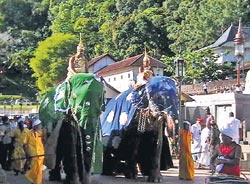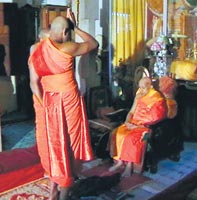
Upasampada: Its revival and continuanceVesak is observed on the last full moon day in May in Thailand and so it is at the two chapters of Asgiri and Malwatta where Upasampada rites were carried out on this full moon Poya day, May 31. The crowning moment of the life of any member of the Sangha is the entry into the Higher Ordination or Upasampada. It is only a member of the Sangha who had been bestowed with upasampada or higher ordination who could perform 'Vas'. This is then, the season for the Buddhist clergy to meditate and also disseminate the dhamma to Buddhists, so that they could develop their mind. However, there was a period in Sri Lanka when Buddhism declined to such an extent that there were no Buddhist priests who had received higher ordination or upasampada rites. Its revival can be attributed to King Kirthi Sri Rajasinghe for bringing this classic tradition from Siam (Thailand ).
The rites and rituals now enacted during the upasampada ceremonies at Asgiri and Malwatta Chapters in Kandy are similar to those enacted 254 years ago, or to be exact on July 20, 1753. It was on July 20, 1753 that the ceremonies were formalised by King Kirthi Sri Rajasinghe by handing over a 'watapatha' or fan made of ola leaves indicating Royal assent. The 'watapatha' is normally used by the clergy for preaching sermons. But, the handing of the 'watapatha' in these ceremonies indicates the mandate of office, even now. In fact, the revival of Buddhism commenced from the period of King Wimaladharmasuriya and later with the reformist movement of Welivita Sri Saranankara Thera. This was the monk who was later elevated to the position of Sangha Nayake (leader of the clergy) by King Kirthi Sri Rajasinghe. During the reign of King Wimaldharmasuriya II, a Chapter of Burmese monks who had visited Sri Lanka bestowed higher ordination to Suriyagoda Unnanse, in the Udu Nuwara electorate. He was later to become the mentor of Welivita Sri Saranankara Thera. These Burmese monks were said to have ordained and delivered higher ordination to those monks qualified to receive the rites at Getambe on the banks of Mahaveli and the gateway to the ancient Kingdom of Kanda Udurata. But, after a period upasampada bestowed by the Burmese monks waned and there was not a single monk with upasampada. It was then that Welivita Thera and King Kirthi Sri Rajasinghe emerged into the limelight and made efforts to have the rites of higher ordination. It would interest readers to know how and why upasampada waned and how the rites were brought again for the last time, and has remained all these years. Buddhism declined mainly due to the infiltration of Catholicism, which spread because of the tolerance of the Kings, who gave a free hand to the missionaries to spread their faith. This decline further increased as the then Buddhist monks were divided into two groups of 'Silvats' and 'Ganinnanses'. Welivita Saranankara Thera was born at Welivita now known as Sangharajapura in the Thumpane Divisional Secretary's division. He wanted to enter the Sangha and was tutored at Suriyagoda. Not satisfied with the learning he went into the present area of Balane and resided there with another boy in two caves. One was used for his meditation and stay, while the other was used for bathing.
However, during the time he led the Silvats, King Narendrasinghe entrusted his brother-in-law of the Nayakkar Dynasty - Sri Vijaya Rajasinghe to be tutored in matters of the State as to how a Buddhist King should rule. Welivita Saranankara Thera now saw an opening to bring higher ordination into the country, by influencing the King. He also secretly yearned that once Vijaya Rajasinghe came to the throne, the new king would embrace Buddhism and reject other religious practices from the Kandyan territory. In the meantime, there was a power struggle in the Kandyan Court when powerful individuals in the Court rallied to enthrone Unambuwa Bandara, alleged to be the illegitimate child of Narendrasinghe. But, Welivita Saranankara Thera would have nothing of this. Perhaps this may be the reason that this firebrand monk has been blamed for having brought Vijaya Rajasinghe to the throne, thereby wiping out the Sinhala Dynasty creating a turning point in the history of the Kandyan Kingdom. However Vijaya Rajasinghe embraced Buddhism and Ven. Welivita Saranankara Thera exerted so much influence on the King that he was able to persuade the King by 1741 to negotiate with the Dutch to accommodate a delegation to Siam. This materialized and on February 20, 1741, the first delegation left for Siam, but perished in the high seas. The second too failed. However, the third delegation which left Kandy on Thursday, July 12, 1751 at the auspicious time of 6.05 a.m. finally made it to Trincomalee and left Lanka's shores on July 25, 1751. Two years later the Sri Lankan delegation with Upali Maha Thera was able to set sail back to Sri Lanka on January 21, 1753 and reached Trincomalee on May 14. The delegation was headed by Upali Thera and comprised Siamese monks. They entered Kandy after a tedious journey on the morning of June 12. Upali Thera was offered accommodation at Malwatta Vihare. A special mandapaya was erected and on the 19th, a pirith ceremony was held with an almsgiving where nearly 200 to 300 persons were present. Getting back to the rituals of the ceremony, the present rites do not vary much from the original rites as practised by Upali Maha Thera in 1753. An account by a Britisher J.A.Dickson who had recorded the event of higher ordination or upasampada at Malwatta Chapter in 1872, was published in the Journal of the Royal Asiatic Society. Very little from that account in 1872 is different from that which is practised now. The novices wend their way to the Sri Dalada Maligawa now and are crowned with the ceremonial crowns either by the Diyawadana Nilame or the Kariya Korale who is the second most important official in the Sri Dalada Maligawa, after the Diyawadana Nilame. From the Sri Dalada Maligawa, the novices, now crowned are mounted on tuskers and are taken in procession thrice round Temple Square and from there to the respective Chapters of Asgiri and Malwatta. The basics of the upasampada ceremony are in the 'Upasampada Kammavaca" which sets out the form and manner of the ceremonies connected with the monks who perform these rites. According to Dickson, this manual has been translated to Italian in 1776 under the title " Kammava Ossia Trattato della ordinazlio dei Yaalopnini del seconde online detti Penzi " by Padre Maria Percoto. I was able to witness the same rituals described by Dickson - in practice- at Asgiri Chapter. The novice accompanied by the tutor makes his obeisance to the Mahanayake Thera of Asgiri. So was the case this particular Poya Day. The tutor recited the ten precepts after which the upasampada ceremony commenced. The presiding member of the Sangha gives an opportunity to anyone present to speak out as to why this particular novice should not be bestowed upasampada confirming the democratic outlook of the process. At the end of the ceremony, the tutors officially inform the presiding member of the clergy that the novice has received higher ordination and the ceremony comes to an end. Upasampada ceremonies in Kandy begin on Vesak Poya Day and end on Poson Day. But, on these Poya days only one member of the Sangha is bestowed Upasampada who is termed "Wahal Naga" and to him the Kings of yesteryear sent robes once he had received higher ordination. On other days the ceremony of upasampada is held at both chapters. Before higher ordination ceremonies are held in the evenings, the novices in their robes are questioned about their education in the Buddha Dhamma. |
|| Front
Page | News | Editorial | Columns | Sports | Plus | Financial
Times | International | Mirror | TV
Times | Funday
Times | Kandy
Times || |
| |
Copyright
2007 Wijeya
Newspapers Ltd.Colombo. Sri Lanka. |

